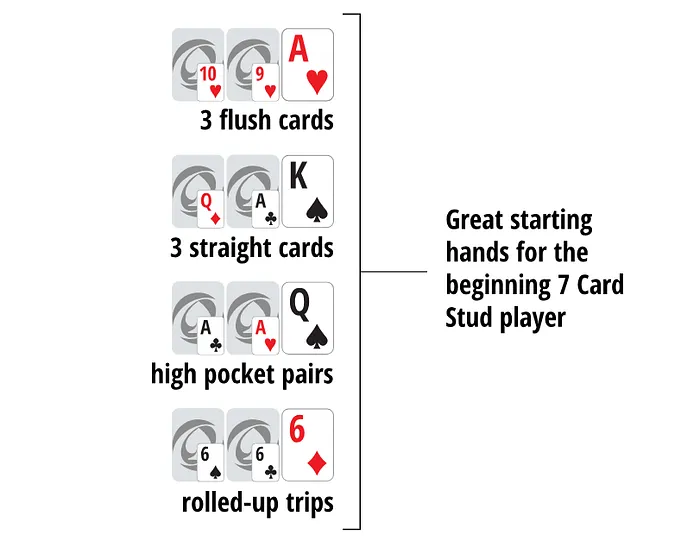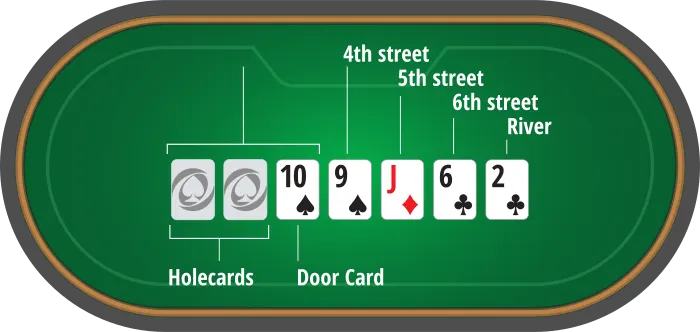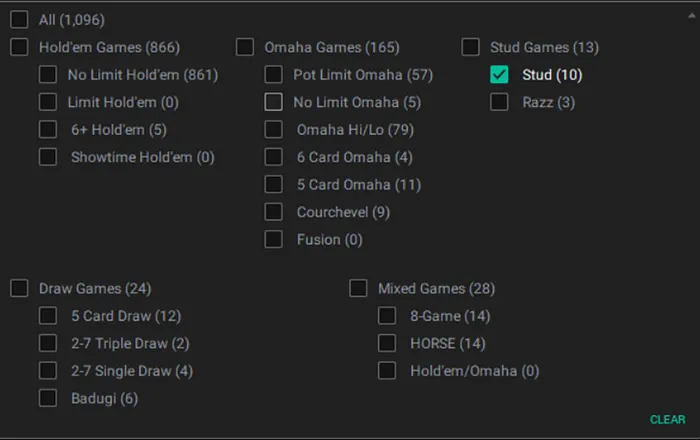Seven-Card Stud Poker Rules
Before Texas Hold'em exploded in popularity, Seven-card Stud was one of the most popular poker variations in the United States.
The game can be played with two to eight players. The biggest difference between seven-card stud and Texas Hold'em or Omaha is that seven-card stud, often simply referred to as Stud, does not involve a flop and usually does not involve community cards.
Instead, players are dealt seven cards over the course of the hand, three face down and four face-up, to make the strongest five-card combination possible.
Here, we go over the poker rules for Seven Card Stud.
Check out the rules and basic strategy to all the popular poker formats
7-Card Stud Rules
Later on in this article, we’ll cover the basics of Stud gameplay, betting rounds and strategy. First, here are some basic 7-Card Stud rules to know and understand.
• Bring-ins – The player with the lowest face-up card begins the betting with the bring-in. In the event of a tie, the bring-in is determined by suit, which are ranked in alphabetical order; clubs (lowest), diamonds, hearts, spades (highest). The lowest suit breaks the tie and pays the bring-in.
• Small and big bets – 7-Card Stud is usually played as a fixed limit game with small bets and big bets, which are worth twice the small bet. Small bets are used on third street and fourth street, while big bets are used on fifth, sixth and seventh street.
• Face-up pairs on fourth street – There is one exception to the above rule. If anyone has a pair showing with their face-up cards on fourth street, players will then have the option to make either small bets or big bets.
• Running out of cards – We mentioned in the introduction that Stud is usually played without community cards, but there is one circumstance in which a community card is needed. In live 7-Card Stud, it’s possible that by seventh street there won’t be enough cards left in the deck to give every player in the pot another card. In this case, a shared community card is dealt on the river.
• Winning the pot – It’s possible to win the pot by being the last player standing or by making showdown. If other players exit the pot by folding and one player remains, they take the chips in the pot. If two or more players are still in the pot following the final betting round, the hand goes to showdown and the best five-card combinations wins.
7-Card Stud Gameplay
In 7-Card Stud, players are dealt seven cards over the course of a hand, three of which are dealt face down and four face up. From these seven cards, players have to create their best five-card combination.
Stud hand rankings are identical to those in Texas Hold 'em or Omaha; a royal flush is the best possible hand, and the worst hand is a high card (no pair).
Before the hand begins, players post their antes. They are then dealt their first three cards, two face down cards, known as the hole cards, and one door card face up. This is followed by the first round of betting.

Players who remain in the hand are then dealt three more cards face-up; known as the fourth, fifth and sixth street, with a round of betting after each. The last card, known as the river, is dealt face down and then the final round of betting takes place.
If two or more players are still in the pot after the river, the hand goes to showdown and the strongest five-card combinations wins the pot.
Antes, Bring In and Betting in 7-Card Stud
In 7-Card Stud, players must place a compulsory ante to see their first three cards. There are up to five rounds of fixed limit betting in each hand of 7-Card Stud, all starting with the bring-in bet on the first round.
Antes
There are no small and big blinds in Stud. Instead, each player pays an ante before the cards are dealt. The size of the ante is determined by the stakes of the game.
7-Card Stud is usually played with a fixed limit structure and the ante typically costs five percent of the big bet. For example, in a $10/$20 7-Card Stud game, the ante will usually be $1.
Once players have paid the compulsory ante bet, they are dealt their first three cards.
Bring In
The bring-in bet initiates the betting action in Stud and is very different to how the hand starts in a game of Texas Hold’em.
In 7-Card Stud, the player with the lowest ranking door card acts first by posting a compulsory known as the bring-in bet. This is the minimum bet possible, typically half of the small bet.
The player who opens the action also has the option to “complete” the bet by posting the full small limit bet, which in a $10/$20 game would be $10.
If the first player to posts the bring-in bet but does not complete, the next player has the option to complete as the first raise.
Betting
7-Card Stud is nearly always played as a fixed limit game. Bet sizing is predetermined and involves a small bet for earlier streets and big bet for later streets.
The small bet is the maximum bet and raise size that players can make on the third and fourth street. The big bet is double the small bet and is reserved for the fifth, sixth and seventh.
In the high version of 7-Card Stud, players can also make the big bet on the fourth street only if their opponent has paired their door card.
There are five rounds of betting in 7-Card Stud. Betting rounds occur after the:
• Third street (small bet)
• Fourth street (small bet and/or big bet if a player’s door card is paired)
• Fifth street (big bet)
• Sixth street (big bet)
• Seventh street (big bet)

Following the bring-in bet on the third street, the action proceeds clockwise around the table. On all subsequent streets, the first player to act is the one who has the strongest hand showing with their face-up cards before continuing in a clockwise direction.
If two or more players are still in the hand after all five rounds of betting, action goes to showdown and the player with the most valuable five-card combination wins the pot.
Best 7-Card Stud Poker Tips and Strategies
7-Card Stud, like all types of poker, is a complex game that involves a mixture of skill and chance. The more you can learn and improve your poker strategy, the more likely you are to see long term results.
The following 7-Card Stud poker tips and strategies will get you started:
Top 5 Winning Tips for 7-Card Stud Poker
Here are five winning tips that will help you to improve at 7-Card Stud poker:
• Starting hands – Be sure to choose strong 7-Card Stud starting hands to continue betting with, such as three of a kind, big pairs and three-card draws.
• Up-cards – Pay attention to your opponent’s upcards, as they can give you a clue as to what they are holding. Likewise, think about your own upcard and what it tells opponents. Blockers are also important.
• Control the pot– Aim to keep the pot smaller with medium strength hands and draws, while raising the maximum when you are very strong.
• Consider pot odds – It’s okay to chase draws, but only if you have the right odds to make the call.
• Play for dead money – Although bluffing can be more difficult to execute in fixed limit games, it still plays a part in 7-Card Stud. It can be worth playing for the antes and bring-in bets.
Top 3 Winning Strategies for 7-Card Stud Poker
Here are three winning strategies that you can apply to your 7-Card Stud poker game:
Making decisions on third street – In 7-Card Stud, you’ll be dealt your first three cards out of seven during the third street, before the first proper round of betting. From then on, you’ll only gain one card per round. As such, your most important decisions occur on third street in Stud, which is why hand selection is so important.
Position in Stud – The bring-in bet is made by the player with the lowest face-up card, which is determined after the cards are dealt. Position then changes on fourth street as it depends on who has the strongest face-up cards. This means position is not static in Stud. Experienced players consider the impact of position throughout the hand.
Betting in Stud – As a fixed limit game, betting strategy differs to in no-limit games like Hold’em. For example, in Stud the implied odds of calling to hit a draw early on in the hand tend to be less, as subsequent betting rounds are capped. Similarly, calling on later streets like the river tends to offer the best pot odds. Bet sizing remains the same as on earlier streets, yet the pot is inflated. Adjust accordingly.
Best Online Poker Sites for Stud Poker
It’s still possible to play Stud poker at major casinos and there’s even a 7-Card Stud event at the World Series of Poker. Having said that, it’s much easier to find Stud games online.
Several of the major online poker rooms have Stud games running on the sites on a daily basis, including PokerStars, 888 Poker and Party Poker.
Play 7-Card Stud Poker on PokerStars
PokerStars is an excellent choice for 7-Card Stud, as it has both tournaments and cash games running on a daily basis. The site also offers a 100 percent deposit match bonus up to $400, making it an ideal choice for new players.
How to Play Stud Poker on PokerStars
Given the user-friendly interface, it’s easy to play Stud on PokerStars. Here’s how to do it:
• Download the software and sign-up for an account
• Once your sign-up is complete, make your first deposit
• Be sure to take advantage of any sign-up offers
• Click the “Cash Game” or “Tourney” tab, depending on what type of game you want to play
• Use the “Game” filter and select “Stud”

What 7-Card Stud Poker Games are on PokerStars?
PokerStars offer 7-Card Stud cash games and tournaments. The tournament buy-ins range from microstakes to midstakes. We found games running for $4.40 up to $22. Cash games run around the clock from $0.50/$1 up to $3/$6.

Stud Poker FAQs
What are the rules of a 7-Card Stud?
In 7-Card Stud, players are dealt seven cards, three face down and four face up, with a total of five rounds of fixed limit betting. Players have to create their best five-card combination at showdown.
What is the difference between Stud Poker and Texas Holdem?
The main difference between Stud Poker and Texas Hold’em, is that there are no community cards in Stud. Instead, each player is dealt seven individual cards.
What is the bring-in in 7 Card Stud?
The bring-in is the first bet made after the third street is dealt. It is a forced bet paid by the player with the lowest door card and kicks off the action.
What is 2-3-5 Stud poker?
2-3-5 Stud is very different to 7-Card and 5-Card Stud, as it is a casino game played against a paytable, not against other players or the dealer. Each player receives three individual cards and can use two community cards to make a five-card combination.
How do you play basic Stud poker?
Like other forms of poker, 7-Card Stud strategy begins with proper hand selection, knowing which hands to bet and when to raise according to the strength of your own hand weighed against face-up cards shown by opponents.
What is the best hand in Stud poker?
Hand rankings in Stud are the same as in other types of poker like Texas Hold’em and Omaha. The best possible hand you can make is the royal flush.
What is the best starting hand in Stud poker?
The best starting hand in Stud poker is three aces. The probability you’ll be dealt this hand is just 0.02 percent. Other strong hands include three of a kind, strong pairs, three cards to a straight flush, three cards to a flush and three cards to a straight.
How to win at 7-Card Stud poker?
In 7-Card Stud, you win by making the best possible five-card combination from the seven cards you are dealt, or by making your opponent fold their hand before showdown.
Do suits matter in a 7-Card Stud?
Yes, as with other poker games, it’s possible to make flushes in 7-Card Stud and so suits do matter. Suits can also determine who makes the bring-in bet if the value of cards are tied.
Do you burn cards in a 7-Card Stud?
Dealers should burn a card before dealing third, fourth, fifth and sixth street in 7-Card Stud. The river presents a unique circumstance. The dealer only burns if there are enough cards left to do so. If there are not enough cards to give each player one, then a community river card is used.
